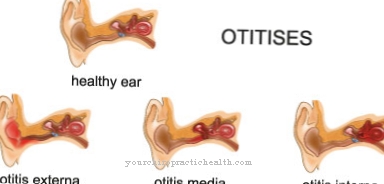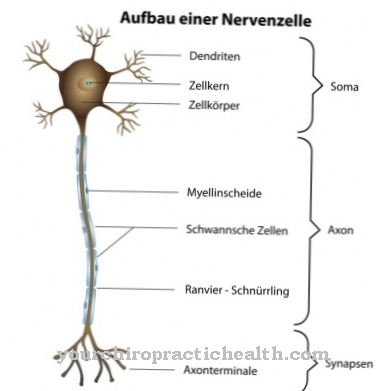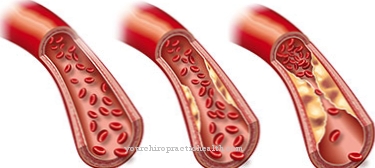Treacher Collins Syndrome is called a hereditary disease that causes facial deformities. The disease is now often called Franceschetti-Zwahlen Syndrome, as Berry syndrome or as Mandibulofacial dysostosis designated. The forms of malformations caused by the syndrome are very variable, but the chin, eyes, ears, palate or zygomatic bone are often affected.
What is Treacher Collins Syndrome?

© Jezper - stock.adobe.com
The Treacher Collins Syndrome refers to a hereditary disease that occurs on average in around 50,000 newborns and is therefore relatively rare. It was discovered in 1900 by the English doctor Edward Treacher Collins. The ophthalmologist was the first to describe the combined and common occurrence and the characteristic features of the syndrome and its symptoms.
His work was continued in 1949 by Adolphe Franceschetti and David Klein. Finally, they also introduced the medical term “dysostosis mandibulofacialis”, which stands for the symptom complex (the complex of complaints and symptoms) of the disease. In addition to the actual Treacher Collins syndrome, some similar gene mutations are known today, such as Elschnig syndrome, which only affects the eyelids. Sometimes these occur together with Treacher Collins syndrome. If one parent already suffers from the syndrome, there is an increased risk that a child will also develop it.
causes
The syndrome is a hereditary disease that is inherited in an autosomal dominant manner. This means that a defective and mutated allele (a type of gene) in the dominant part of the inheritance is sufficient to cause the disease characteristics to develop. Since the information is on one of the 22 autosome pairs and not on the sex chromosomes, Treacher-Collins syndrome is inherited regardless of gender.
For example, if one parent already suffers from the syndrome, the child has a 50 percent risk of developing it as well. If both parents suffer from the syndrome, the risk increases to 75 to 100 percent. Here it depends on whether the parents are heterozygous or homozygous - i.e. whether there are identical or different alleles. The syndrome can also skip generations.
Symptoms, ailments & signs
The symptoms and characteristics of the syndrome can vary considerably and are rarely predictable or similar, even in parents who are already sick. Today there are also very mild forms of the disease as well as life-threatening cases.Because with Treacher-Collins syndrome there are not only deformities in the visible area of the face, but the respiratory tract or the bone conduction can also be affected. However, the syndrome is often characterized by bilateral symptoms.
These express themselves, for example, in a deformity of the zygomatic bone (called Os zygomaticum), a faulty formation of the lower jaw bone (called mandible) or the auricle (called auricula). In addition, malformations such as a cleft palate, deformed eyelids, incorrect eye positions, visual disturbances, hearing disorders and breathing problems due to an obstruction of the airways can be consequences of the syndrome.
Diagnosis & course of disease
The diagnosis of Treacher Collins syndrome is usually based on clinical findings: after birth or even in the womb. A frequently used method to diagnose the syndrome today is, for example, the OMENS classification. This evaluates the severity of the symptoms with regard to the orbit (eye socket), the mandible, the ear, the facial nerve and the soft tissue of the face area (soft tissue).
In addition, however, to be really sure, various radiological examinations should always be carried out. These can often be used to estimate the severity and extent of the disease. Finally, however, genetic diagnostics carried out at the molecular level can also secure the diagnosis - and provide clarity.
Complications
In Treacher Collins syndrome, the complications are based on malformations. The hereditary disease can manifest itself, for example, in the incorrect formation of the lower jaw bone. If there is such a malformation, problems with food intake may arise. In babies, inadequate nutrition can quickly lead to deficiency symptoms.
Furthermore, as part of the Treacher-Collins syndrome, there may be a malformation of the auricle, which can be associated with hearing disorders. Other malformations such as a cleft palate or deformed eyelids are associated with individual complications. Typical secondary complaints are breathing problems, visual disturbances and functional disturbances of the sense of smell, but also diseases of the bone conduction.
Aesthetic malformations are a psychological burden for most of those affected. If therapeutic counseling is not given early on, social phobias and inferiority complexes can develop, which often last a lifetime. There can also be complications in treating Treacher-Collins syndrome.
Surgical interventions always carry a certain risk of surgical errors, which can cause various problems depending on the location of the operation. Injuries to nerves, vessels or tissue structures are typical, which can lead to, for example, sensory disorders and functional disorders. Drug treatment of young children is always associated with certain risks.
When should you go to the doctor?
With Treacher Collins syndrome, the person concerned depends on medical treatment and examination so that there are no further complications or complaints. An early diagnosis with subsequent treatment always has a positive effect on the further course of the disease and can prevent the symptoms from worsening.
In the case of Treacher Collins syndrome, a doctor should be consulted if the person concerned suffers from severe malformations or deformities. These occur all over the body and have a very negative effect on the quality of life of the person concerned. Visual or hearing problems can also indicate the syndrome and should also be examined by a doctor. Most people with Treacher Collins syndrome also suffer from respiratory problems, so these symptoms should also be checked by a doctor.
A general practitioner can be contacted for Treacher Collins syndrome. Further treatment depends heavily on the type and exact severity of the symptoms, so that no general course can be given. If you want to have children, genetic counseling can also be carried out.
Treatment & Therapy
The type and success of treatment in Treacher Collins syndrome always depend on the complexity and severity of the symptoms. Today, purely aesthetic malformations can often be treated very well with modern plastic surgery. This also applies to numerous malformations caused by the syndrome that would affect the infant's quality of life but do not threaten his or her life - such as a malformation of the eyelids, a slight cleft palate or minimal deformities of the auricles.
The situation is different with life-threatening manifestations of the syndrome, such as a deformity of the airways. Characteristics like these can often be treated with surgical interventions. However, it is important that the treatment happens as quickly as possible - sometimes even in the womb. In addition, it is not uncommon for symptoms such as hearing or visual damage, which can also be triggered by the syndrome, to be treated. This often requires close cooperation between the various treating specialists and specialists.
prevention
Treacher Collins syndrome cannot be prevented. At most, it is possible to estimate in advance the level of risk that the child will develop it. And: Many manifestations and symptoms can often be treated if this is done in good time and if necessary. For this reason, parents suffering from the syndrome or parents whose families have already suffered from Treacher Collins syndrome should definitely inform the treating gynecologist - so that he can establish contact with specialists as early as possible.
They will then usually accompany the pregnancy with various diagnoses and intervene if necessary: but at the latest after the birth, in order to treat even mild forms of the syndrome as best as possible and to improve the quality of life of the child concerned.
Aftercare
Follow-up care for Treacher Collins syndrome depends on how severe the facial malformations are and what other symptoms are also occurring. Follow-up care always includes a physical exam and a conversation with the patient. The course of the malformations is checked during the physical examination.
Further treatment is required if complications such as inflammation or sensory disorders arise. As part of the anamnesis, side effects and interactions of the prescribed medication are checked. In addition, open questions from the patient are clarified. If no complications arise, the patient can be discharged.
However, since Treacher Collins syndrome is a chronic condition, the individual symptoms must be treated permanently. Regular check-ups by the doctor are necessary in order to be able to quickly resolve symptoms that may arise in the course of the disease and to avoid serious complications. For this, a specialist clinic usually has to be visited.
The routine checks, however, can be carried out by the family doctor. However, this always depends on the severity of the disease. Follow-up care for Treacher Collins syndrome is carried out by the general practitioner, ear specialist, internist or surgeon, depending on the symptoms. For children, the pediatrician is usually involved in the treatment.
You can do that yourself
Treacher Collins syndrome is characterized by complex malformations and physical limitations. The self-help measures are based on the individual complaints.
After a corrective operation, general measures such as rest, rest and compliance with medical guidelines apply. Any wounds or scars should be cared for in consultation with a dermatologist in order to minimize the skin changes. Affected people must contact an ENT specialist and an ophthalmologist at an early stage so that the respective complaints can be treated. The therapy of hearing loss can be supported by wearing a hearing aid.
The Treacher Collins Syndrome always means psychological stress for those affected. The malformations can massively impair self-esteem and cause serious mental illness. That is why contact with other affected persons and specialists who point out treatment prospects is one of the most important self-help measures. Patients with Treacher Collins Syndrome are best advised to go to a specialist clinic or to contact other patients on the Internet. The association ACHSE e. V. supports people with rare diseases and gives them further tips and contact points with the help of which medical therapy can be specifically supported.



























